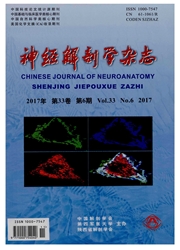

 中文摘要:
中文摘要:
目的:研究双轴旋转运动刺激前庭感受器诱导晕动病后大鼠中央杏仁核(Ce A)神经元树突棘可塑性变化,探讨Ce A在晕动病中的作用。方法:6只成年雄性SD大鼠分为两组:对照组和旋转刺激组。旋转刺激组大鼠经2 h双轴旋转运动刺激(大、小转盘分别以168°/s和432°/s的角速度(33和72 r/min)旋转),然后取脑、切片(100μm),应用Golgi-Cox染色技术观察Ce A神经元树突棘并计数,统计分析后比较两组间的差异。结果:旋转运动刺激后,Ce A神经元树突棘密度增高,即对照组为(4.58±1.90/10μm),旋转刺激组为(6.57±2.43/10μm),两组差异具有统计学意义。结论:诱导晕动病发生的旋转运动刺激可引起大鼠Ce A神经元树突棘数量增加,Ce A神经元可接收来自前庭神经核的神经传入参与晕动病反应。
 英文摘要:
英文摘要:
Objective: To investigate the plasticity of dendritic spine associated with central amygdaloid nucleus (CeA) neurons after motion sickness (MS) induced by double rotation to stimulate the vestibular end organ and to explore the role of CeA in genesis of MS. Methods:Six adult male Sprague-Dawley (SD) rats were equally divided into two groups, i.e. control and rotation stimulation groups. Animals in the rotation group were subjected to double axes rotation for 2 h with angular velocity of 168°/s and 432°/s for large and small rotation discs, respectively. Both groups of animals' brains were removed and cut into coronal slices of 100 Izm thick. The slices were stained by Golgi-Cox methods and the dendritic spines of CeA were counted. The measurements were finally analyzed and statistically compared between two groups. Results:The density of dendritic spine of CeA neurons increased significantly (4.58 ± 1.90/10 μm vs. 6.57 ± 2.43/10 μm for control and rotation group, respectively) after double axes rotation stimulation (P 〈 0.05 ). Conclusion: The motion sickness-inducing'rotation stimulus could increase the number of dendritic spine of rat CeA neurons, and CeA neurons can receive impulses from vestibular afferents, which participate in the genesis of motion sickness.
 同期刊论文项目
同期刊论文项目
 同项目期刊论文
同项目期刊论文
 期刊信息
期刊信息
